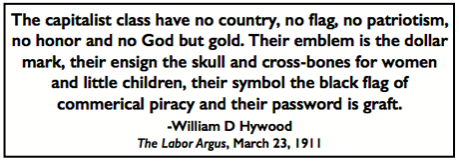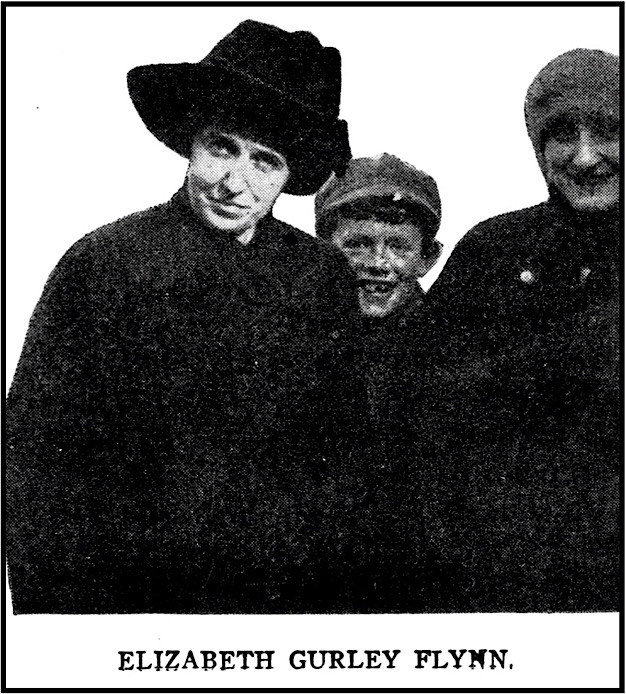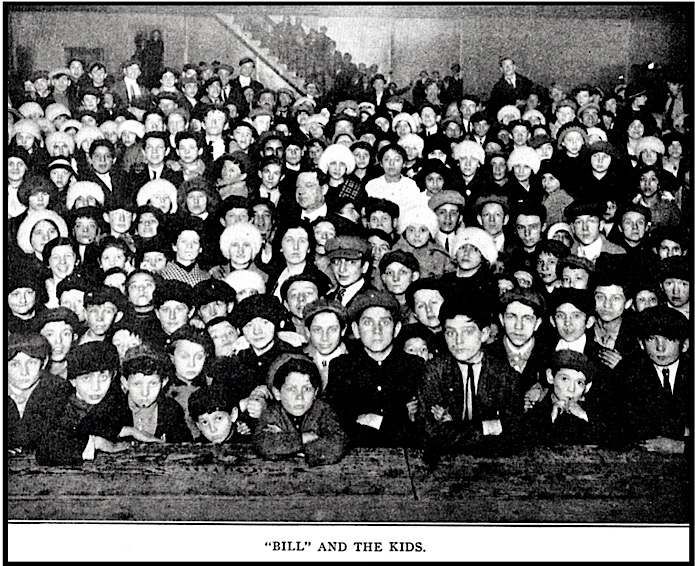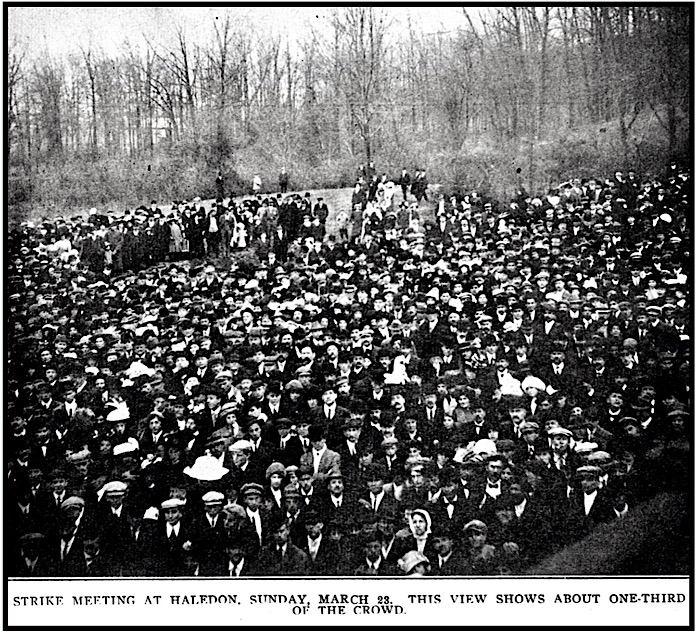 —————
—————
Hellraisers Journal – Saturday May 3, 1913
Paterson, New Jersey – Bill Haywood on the General Strike of Silk Workers, Part II
From the International Socialist Review of May 1913:
The Rip in the Silk Industry
By William D. Haywood
———-[Part II of II]
The Red Badge of Toil
In this connection it is worth while to relate an incident-one of the most dramatic of the strike. The Paterson bosses lost no time in injecting the “patriotic” issue after the fashion of Lawrence, Little Falls and Akron. The red flag, they howled, stood for blood, murder and anarchy-the Star Spangled Banner must be upheld, etc., etc. Elizabeth Gurley Flynn was on the platform at a big strike meeting one day explaining the significance of the red flag when a striking dyer sprang up from the middle of the audience crying:
“I know ! Here is the red flag!”
And aloft he held his right hand-stained a permanent bloody crimson, gnarled from years of toil, and corroded by the scarlet dye which it was his business to put into the fabrics worn by the dainty lady of the capitalist class as well as by the fawning prostitute.
For an instant there was silence and then the hall was rent by cries from the husky throats as all realized this humble dyer indeed knew the meaning of the red badge of his class.
Ribbon weaving is largely done by men and women. In this department the bosses have developed a speeding up system with reductions in pay, overlooking no opportunity to introduce improved machinery. Thus they increase production, at the same time they lowered the pay, until the workers are now demanding a scale which 19 years ago was imposed upon them! That is, the weavers now ask a wage that prevailed two decades ago.
The significance of this demand makes it plain that in the evolution of industry and the introduction of new machinery the workers have obtained no benefit, while the bosses have reaped ever increasing profits.
Many children are employes in the silk industry, most of them being between the ages of 14 and 16. However there are few violations of the child labor law, not because. the manufacturers care anything about either the law or the children, but because the making of high grade silk requires the careful and efficient work that only adults can give. However the Paterson capitalists have begun to set up plants in the southern states as well as in the mining regions of Pennsylvania, installing there new style looms which can be operated by girls and children.
Meeting For Children
One of the best and most enthusiastic meetings held during the strike was that for the benefit of the children of the mills. They packed Turner Hall and listened eagerly and with appreciation as speakers outlined to them the development in the manufacture of silk from the cocoon to the completed fabric lying on the shelves of the rich department store.
The strike has been viciously fought from the very beginning. The usual combination of press, pulpit and police has labored both openly and secretly to weaken it and break it, but without avail. For seven weeks the Paterson newspapers have delivered screams of rage and fury day after day. They have not hesitated to urge any measure that might break the strike, from tar-and-feathers to murder. Day after day in big, black headlines in their front pages they have demanded that the “I. W. W. blatherskites” be driven out of town. They have constantly incited the police to violence and urged the authorities to take “drastic measures.” All in vain. On the day this is written the leading organ of the manufacturers admits that the police, the administration and the courts have been helpless and it now begs the workers themselves to “drive the I. W. W. out of town,” promising that if they will organize into “a decent, dignified, American union,” the whole city will demand that the bosses give them the conditions for which they ask.
Little Violence
Despite this, another paper admits in its editorial columns that Paterson after all ought to be thankful. “Though 25,000 people have been on strike here for seven weeks,” it says, “there has been remarkably little violence.”
As was the case in Lawrence, nearly every nationality on earth is represented in the strike. The Italians and Germans are the most numerous, with thousands of Russians, Poles, Hungarians and Armenians besides. Shoulder to shoulder they have stood, with a spirit and loyalty that nothing could break or weaken. For seven long weeks they have held out and in place of food many of them have simply taken up another link in their belts and drunk a glass of water. Some relief money has come in but not enough to help any except the most needy cases.
Incidents without number could be given to show the spirit of self sacrifice and devotion among the Paterson workers. The jail has had no terrors for them, since accommodations there are hardly worse than in the “homes” they are compelled to live in. On occasions when the police have started wholesale arrests they have vied with each other in placing themselves in the hands of the ”bulls.” One day when the police gathered in more than 200 of them, they refused to walk to jail but demanded the patrol wagon. When the police pleaded that the patrol wagon would hold only a few at a time, they said they would wait! And the patrol wagon the police were compelled to get, making trip after trip to the jail while the arrested strikers stood in a group and laughed and sang.
The meetings we have held have been wonders. Day after day the strikers have crowded into Turn and Helvetia Halls with enthusiasm just as rampant as one the first day of the strike and on the Sundays when the Socialist city of Haledon is visited, at the invitation of Socialist Mayor William Brueckmann, for open air meetings, it has seemed as if the whole population of the northern part of New Jersey was present. To speak at such meetings is worth a whole lifetime of agitation.
[Emphasis added.]
~~~~~~~~~~~~~~~~~~~~~~~~~
SOURCES & IMAGES
Quote BBH Corporation Soul, Oakland Tb p11, Mar 30, 1909
https://www.newspapers.com/image/72436098/
International Socialist Review
(Chicago, Illinois)
-May 1913
https://www.marxists.org/history/usa/pubs/isr/v13n11-may-1913-ISR-riaz-ocr.pdf
See also:
Hellraisers Journal: From the International Socialist Review:
“The Rip in the Silk Industry” by Bill Haywood, Part I
Annual Report of the Bureau of Statistics of Labor and Industries
of New Jersey, for the Year Ending October 1913
NJ Bureau of Statistics of Labor and Industries, 1914
(search: paterson silk strike 1913)
(search with last names from article above)
https://books.google.com/books?id=EDUaAQAAIAAJ
Tag: Paterson Silk Strike of 1913
https://weneverforget.org/tag/paterson-silk-strike-of-1913/
~~~~~~~~~~~~~~~~~~~~~~~~~
There Is Power in a Union – John McCutcheon
Lyrics by Joe Hill



